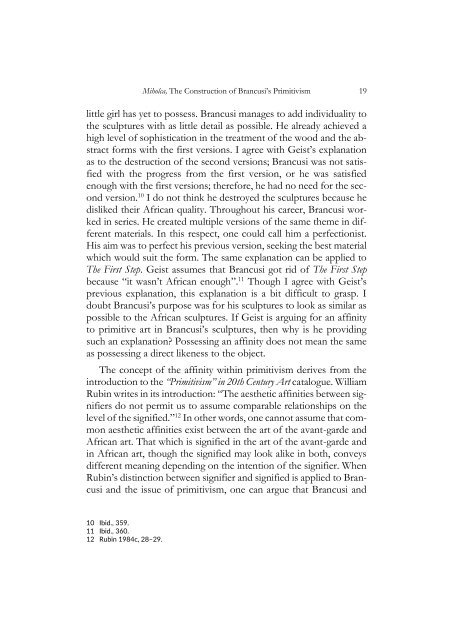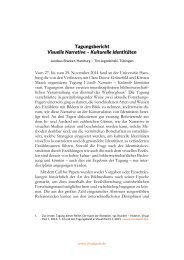The Construction of Brancusi’s Primitivism
Create successful ePaper yourself
Turn your PDF publications into a flip-book with our unique Google optimized e-Paper software.
Miholca, <strong>The</strong> <strong>Construction</strong> <strong>of</strong> <strong>Brancusi’s</strong> <strong>Primitivism</strong> 19<br />
little girl has yet to possess. Brancusi manages to add individuality to<br />
the sculptures with as little detail as possible. He already achieved a<br />
high level <strong>of</strong> sophistication in the treatment <strong>of</strong> the wood and the abstract<br />
forms with the first versions. I agree with Geist’s explanation<br />
as to the destruction <strong>of</strong> the second versions; Brancusi was not satisfied<br />
with the progress from the first version, or he was satisfied<br />
enough with the first versions; therefore, he had no need for the second<br />
version. 10 I do not think he destroyed the sculptures because he<br />
disliked their African quality. Throughout his career, Brancusi worked<br />
in series. He created multiple versions <strong>of</strong> the same theme in different<br />
materials. In this respect, one could call him a perfectionist.<br />
His aim was to perfect his previous version, seeking the best material<br />
which would suit the form. <strong>The</strong> same explanation can be applied to<br />
<strong>The</strong> First Step. Geist assumes that Brancusi got rid <strong>of</strong> <strong>The</strong> First Step<br />
because “it wasn’t African enough”. 11 Though I agree with Geist’s<br />
previous explanation, this explanation is a bit difficult to grasp. I<br />
doubt <strong>Brancusi’s</strong> purpose was for his sculptures to look as similar as<br />
possible to the African sculptures. If Geist is arguing for an affinity<br />
to primitive art in <strong>Brancusi’s</strong> sculptures, then why is he providing<br />
such an explanation Possessing an affinity does not mean the same<br />
as possessing a direct likeness to the object.<br />
<strong>The</strong> concept <strong>of</strong> the affinity within primitivism derives from the<br />
introduction to the “<strong>Primitivism</strong>” in 20th Century Art catalogue. William<br />
Rubin writes in its introduction: “<strong>The</strong> aesthetic affinities between signifiers<br />
do not permit us to assume comparable relationships on the<br />
level <strong>of</strong> the signified.” 12 In other words, one cannot assume that common<br />
aesthetic affinities exist between the art <strong>of</strong> the avant-garde and<br />
African art. That which is signified in the art <strong>of</strong> the avant-garde and<br />
in African art, though the signified may look alike in both, conveys<br />
different meaning depending on the intention <strong>of</strong> the signifier. When<br />
Rubin’s distinction between signifier and signified is applied to Brancusi<br />
and the issue <strong>of</strong> primitivism, one can argue that Brancusi and<br />
10 Ibid., 359.<br />
11 Ibid., 360.<br />
12 Rubin 1984c, 28–29.



